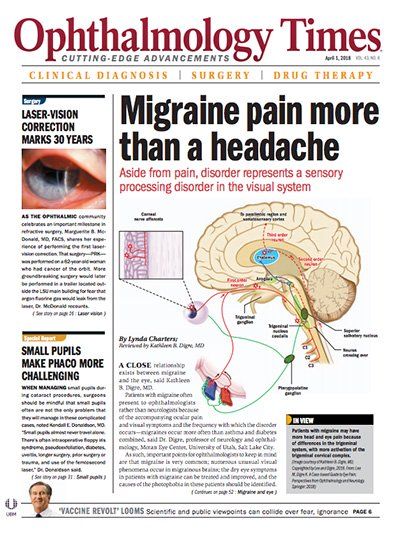Publication
Article
Digital Edition
Intraop wavefront aberrometry may enhance results in toric IOL surgery
Findings of a study determining the prediction error in the magnitude of residual astigmatism after cataract surgery with a toric intraocular lens (IOL) suggest that use of intraoperative wavefront aberrometry for toric power selection could enhance the refractive outcome in a large subset of eyes.
By Cheryl Guttman Krader
Findings of a study determining the prediction error in the magnitude of residual astigmatism after cataract surgery with a toric intraocular lens (IOL) suggest that use of intraoperative wavefront aberrometry for toric power selection could enhance the refractive outcome in a large subset of eyes.
The study included 50 eyes of 38 patients implanted with a toric IOL (SN6ATx; AcrySof IQ Toric IOL, Alcon Laboratories). In all cases, the toric power of the implanted IOL was determined using an intraoperative wavefront aberrometer (ORA System, Alcon Laboratories). The residual astigmatism predicted by the device was noted.
In addition, IOL power calculation was performed for all eyes with the toric IOL manufacturer’s online calculator that uses the Barrett Toric Algorithm, a nomogram that theoretically accounts for posterior corneal astigmatism. Using the subjective refraction measured at 3 months postoperatively, the predicted residual astigmatism for the implanted toric IOL was back-simulated using the toric IOL calculator.
For the main outcome analysis, the difference vector was calculated for each prediction method by subtracting the predicted residual astigmatism vector from the observed postoperative astigmatism vector.
Two methods compared
The median of the magnitude of the astigmatism difference vector (MedAE) was compared for the 2 methods, and the results showed that the overall prediction error in residual astigmatism was the same for the intraoperative wavefront aberrometer and the toric IOL calculator.
However, in a subgroup of 26 eyes in which there was a mismatch between the implanted toric power determined by intraoperative wavefront aberrometry and that suggested by the toric IOL calculator, the prediction error for the same implanted toric power was significantly lower using the intraoperative wavefront aberrometer compared with the toric IOL calculator.
“We have found preliminary evidence that intraoperative wavefront aberrometry can increase the accuracy of residual astigmatism prediction in a significant subset of eyes when compared to a recently introduced toric IOL calculator that already accounts for posterior corneal astigmatism,” said Miguel Raimundo, MD, Department of Ophthalmology, Centrao Hospitalar e Universitário de Coimbra, Coimbra, Portugal.
“Nonetheless, further studies are warranted, for instance for replication of the findings, using a larger sample size, or to address some of our study’s limitations,” Dr. Raimundo added. “One of these might be testing other sources of anterior keratometry data because this might compromise the accuracy of the preoperative calculation.”
Is technique useful?
Dr. Raimundo and colleagues were motivated to conduct this study because evidence on the use of intraoperative wavefront aberrometry to guide toric IOL power selection is relatively scarce.
“To the best of our knowledge, only three studies exist,” Dr. Raimundo pointed out. “Two studies showed it improved toric outcomes, but the third showed that intraoperative computed-assisted registration with a preoperative toric calculator yielded less remaining refractive cylinder than intraoperative wavefront aberrometry. So, the debate is still open on the usefulness of the technique.”
The 50 eyes included in the study represented a consecutive series that underwent uncomplicated surgery. Eyes were excluded if they had preoperative best-corrected visual acuity (BCVA) <20/40, cornea ectasia, previous refractive surgery, any conditions that would compromise the accuracy of the postoperative refraction, or any additional astigmatism corrective procedure.
Preoperative biometry measurements were obtained with the same device (IOLMaster 500, Carl Zeiss Meditec) in all cases. The intraoperative wavefront aberrometry measurements were taken after the anterior chamber was inflated to a normotensive level with cohesive viscoelastic, as verified by a Barraquer tonometer.
Difference in 26 eyes
Among the 26 eyes in which the cylindrical power selected by intraoperative wavefront aberrometry differed from that recommended by the toric IOL calculator, intraoperative wavefront aberrometry recommended a lower power than the toric IOL calculator in 19 eyes.
To assess if the eyes in which a mismatch occurred differed in any way from those where the 2 methods suggested the same power, the biometric data of the 2 subgroups was compared. The analyses showed no significant differences in mean preoperative keratometry, corneal astigmatism, axial length, or anterior chamber depth.
“In the subgroup of eyes where the IOL toric calculator would have predicted a different IOL cylindrical power, we found the intraoperative wavefront aberrometer was able to get a lower median absolute error for residual astigmatism compared to the toric IOL calculator,” Dr. Raimundo said.
Miguel Raimundo, MD
This article is based on a presentation given by Dr. Raimundo at 2017 American Academy of Ophthalmology meeting. Dr. Raimundo has no relevant financial interests to disclose.
Newsletter
Don’t miss out—get Ophthalmology Times updates on the latest clinical advancements and expert interviews, straight to your inbox.





